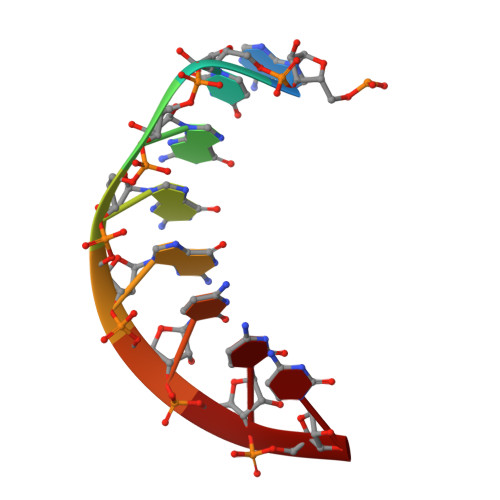Sequential structures provide insights into the fidelity of RNA replication
Ferrer-Orta, C., Arias, A., Perez-Luque, R., Escarmis, C., Domingo, E., Verdaguer, N.(2007) Proc Natl Acad Sci U S A 104: 9463-9468
- PubMed: 17517631
- DOI: https://doi.org/10.1073/pnas.0700518104
- Primary Citation of Related Structures:
2E9R, 2E9T, 2E9Z, 2EC0 - PubMed Abstract:
RNA virus replication is an error-prone event caused by the low fidelity of viral RNA-dependent RNA polymerases. Replication fidelity can be decreased further by the use of mutagenic ribonucleoside analogs to a point where viral genetic information can no longer be maintained. For foot-and-mouth disease virus, the antiviral analogs ribavirin and 5-fluorouracil have been shown to be mutagenic, contributing to virus extinction through lethal mutagenesis. Here, we report the x-ray structure of four elongation complexes of foot-and-mouth disease virus polymerase 3D obtained in presence of natural substrates, ATP and UTP, or mutagenic nucleotides, ribavirin triphosphate and 5-fluorouridine triphosphate with different RNAs as template-primer molecules. The ability of these complexes to synthesize RNA in crystals allowed us to capture different successive replication events and to define the critical amino acids involved in (i) the recognition and positioning of the incoming nucleotide or analog; (ii) the positioning of the acceptor base of the template strand; and (iii) the positioning of the 3'-OH group of the primer nucleotide during RNA replication. The structures identify key interactions involved in viral RNA replication and provide insights into the molecular basis of the low fidelity of viral RNA polymerases.
Organizational Affiliation:
Institut de Biologia Molecular de Barcelona, Parc Científic de Barcelona, Josep Samitier 1-5, E-08028 Barcelona, Spain.


















